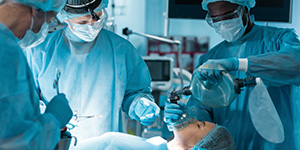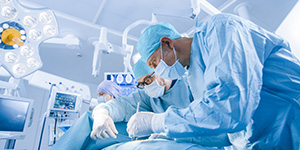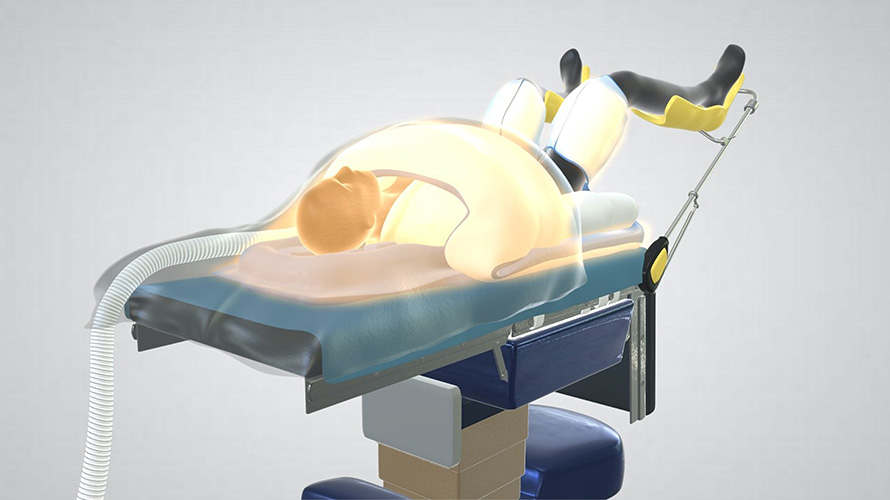Robotic-assisted surgeries are revolutionizing the medical field, but they present significant challenges, particularly in surgical positioning and maintaining patient warmth. From urology to gynecology, issues like patient sliding and hypothermia are ongoing concerns for OR directors, robotic leads, and surgeons. Effective surgical positioning is crucial for ensuring precision, minimizing complications, and enhancing overall patient safety.
The Opt-Shield™ Air Trendelenburg System is transforming these procedures by providing a dual solution for patient stability and warming. Developed by an experienced anesthesiologist, this system addresses critical issues such as patient sliding, injury, and hypothermia during Trendelenburg positioning, leading to improved outcomes in robotic-assisted procedures, including prostatectomy, colorectal resection, and hysterectomy.
Robotic-Assisted Prostatectomy: Advancing Urological Precision
Robotic-assisted prostatectomy has transformed urological surgery by providing greater precision and shorter recovery times. However, this minimally invasive approach brings unique challenges, especially in patient positioning. The steep Trendelenburg position required for robotic-assisted prostatectomy increases the risk of patient sliding and injury, which can compromise surgical accuracy. Additionally, prolonged exposure to the cool OR environment can lead to patient hypothermia, negatively impacting recovery.
The Opt-Shield Air Trendelenburg System offers an innovative solution to these challenges. With its enhanced patient stability features, including an upper torso padding system designed to evenly distribute weight, it ensures that patients up to 400 pounds remain securely positioned throughout the procedure, minimizing the risk of sliding. Furthermore, its temperature regulation capabilities help manage hypothermia, keeping patients warm from above and below, which reduces complications such as intra-operative bleeding, post-operative infection, and accelerates wake-up time after surgery.
For robotic surgeons, precision is crucial in urological procedures, and the Opt-Shield Air Trendelenburg System supports this by ensuring stable, consistent patient positioning throughout the surgery. Additionally, robotic leads and staff benefit from the system’s ability to address critical concerns such as patient stability and reduced prep time, streamlining the surgical positioning process and improving overall efficiency.
Robotic-Assisted Colo-Rectal Resection Surgery: Improving Surgical Efficiency
Colo-rectal resection surgery is another area where robotic-assisted techniques have improved surgical efficiency and patient outcomes. However, lengthy procedures require stable and precise positioning to minimize patient movement and ensure surgical accuracy. Surgeons face the additional challenge of maintaining patient comfort and reducing sliding, particularly during complex resections.
The Opt-Shield Air Trendelenburg system addresses these concerns by offering superior stability and comfort during long procedures. Its design minimizes patient sliding, ensuring that surgical positioning remains optimal throughout the operation. By reducing the risk of patient movement, the system allows surgeons to focus on the task at hand, ultimately improving surgical efficiency and outcomes.
For colo-rectal and general surgeons, the Opt-Shield Air Trendelenburg system enhances precision by stabilizing the patient, which is critical for delicate procedures. Robotic leads and coordinators benefit from the system’s ability to simplify patient preparation and setup, making it an invaluable tool for ensuring smooth, coordinated surgical efforts.
Hysterectomy: Optimizing Gynecological Surgery
Robotic-assisted hysterectomies have become a preferred method for many gynecology surgeons, thanks to the precision and control offered by robotic systems. However, these procedures require careful patient positioning to accommodate robotic arms and instruments, and maintaining stability throughout the surgery is crucial. Additionally, extended hysterectomies increase the risk of patient discomfort and positioning issues.
The Opt-Shield Air Trendelenburg system provides the support needed to ensure stable and precise positioning, allowing surgeons to work with greater accuracy. The system’s ability to maintain patient comfort and prevent movement during long procedures is a significant advantage for both surgeons and patients, leading to better surgical outcomes.
For gynecology surgeons, the Opt-Shield Air Trendelenburg system is an essential tool in robotic-assisted hysterectomies, as it enhances surgical precision and patient care. Robotic leads also benefit from the system’s ability to simplify patient preparation and ensure stable positioning throughout the procedure, providing critical support for successful surgical outcomes.
Elevate Patient Care with the Opt-Shield Air Trendelenburg System
Patients undergoing robotic-assisted surgeries in the Trendelenburg position face risks such as sliding, brachial plexus injury, and hypothermia. The Opt-Shield Air Trendelenburg System minimizes these risks by providing secure positioning, virtually eliminating the chance of brachial plexus injury. In fact, over 15,000 surgeries have been performed using the Opt-Shield system without a single incident of brachial plexus injury. Whether performing a prostatectomy, colo-rectal resection, or hysterectomy, the system’s ability to maintain stable positioning, regulate temperature, and prevent patient sliding makes it an invaluable tool in the operating room.
OR directors, robotic leads, coordinators, and surgeons—consider integrating the Opt-Shield Air Trendelenburg system into your surgical suite. By doing so, you can enhance patient safety, improve surgical outcomes, and streamline your surgical processes.










